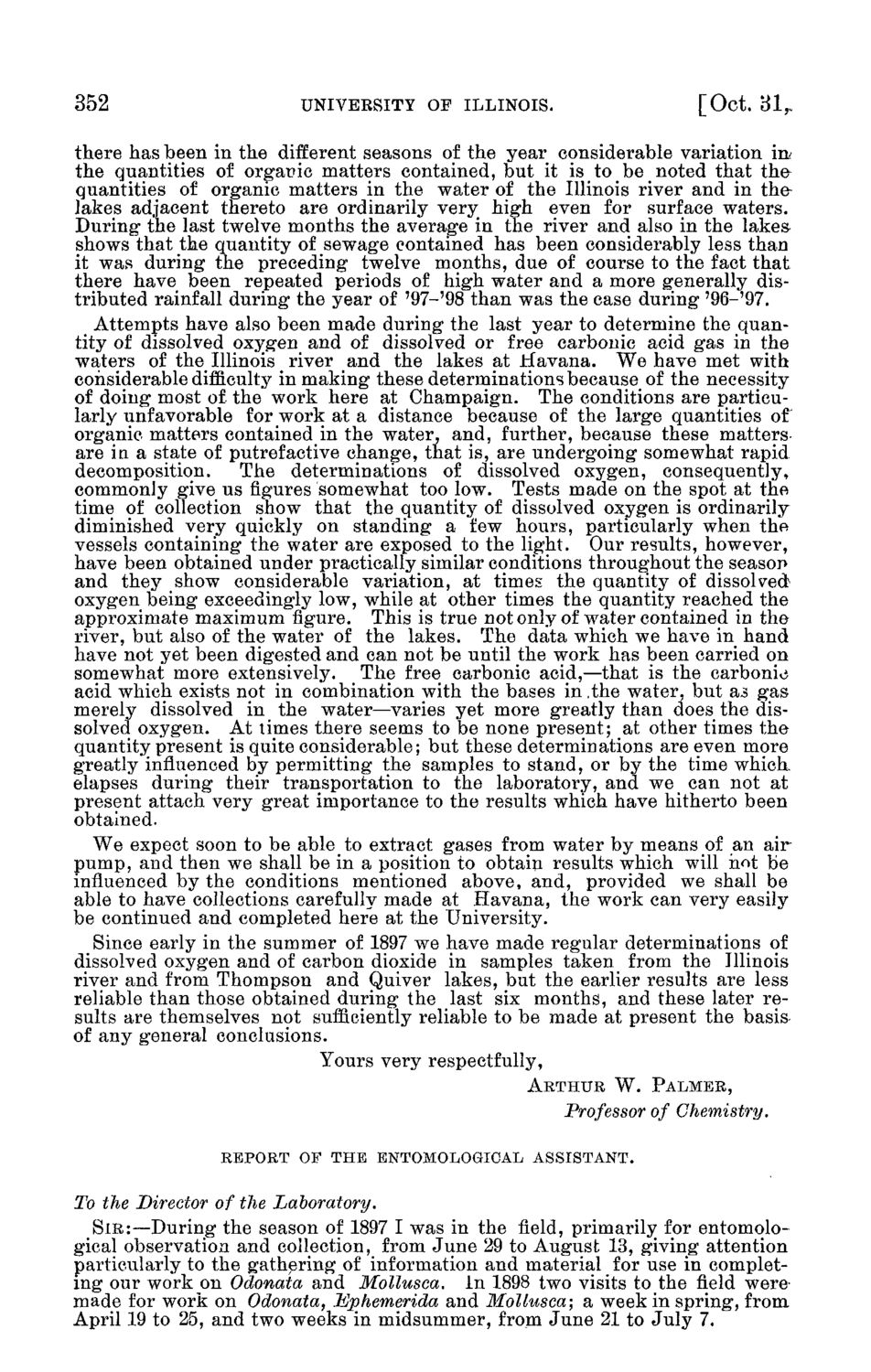| |
| |
Caption: Board of Trustees Minutes - 1898
This is a reduced-resolution page image for fast online browsing.

EXTRACTED TEXT FROM PAGE:
352 UNIVERSITY OF ILLINOIS. [Oct. 3 1 r there has been in the different seasons of the year considerable variation in.' the quantities of organic matters contained, but it is to be noted that th& quantities of organic matters in the water of the Illinois river and in thelakes adjacent thereto are ordinarily very high even for surface waters. During the last twelve months the average in the river and also in the lakes shows that the quantity of sewage contained has been considerably less than it was during the preceding twelve months, due of course to the fact that there have been repeated periods 7 of high water and a more generally distributed rainfall during the year of 97-'98 than was the case during '96-'97. Attempts have also been made during the last year to determine the quantity of dissolved oxygen and of dissolved or free carbonic acid gas in the waters of the Illinois t river and the lakes at Havana. We have met with considerable difficulty in making these determinations because of the necessity of doing most of the work here at Champaign. The conditions are particularly unfavorable for work at a distance because of the large quantities of organic matters contained in the water, and, further, because these mattersare in a state of putrefactive change, that is, are undergoing somewhat rapid decomposition. The determinations of dissolved oxygen, consequently, commonly give us figures somewhat too low. Tests made on the spot at the time of collection show that the quantity of dissolved oxygen is ordinarily diminished very quickly on standing a few hours, particularly when the vessels containing the water are exposed to the light. Our results, however, have been obtained under practically similar conditions throughout the season and they show considerable variation, at times the quantity of dissolved oxygen being exceedingly low, while at other times the quantity reached the approximate maximum figure. This is true not only of water contained in the river, but also of the water of the lakes. The data which we have in hand have not yet been digested and can not be until the work has been carried on somewhat more extensively. The free carbonic acid,—that is the carbonic acid which exists not in combination with the bases in .the water, but as gas merely dissolved in the water—varies yet more greatly than does the dissolved oxygen. At times there seems to be none present; at other times the quantity present is quite considerable; but these determinations are even more greatly influenced by permitting the samples to stand, or by the time which, elapses during their transportation to the laboratory, and we can not at present attach very great importance to the results which have hitherto been obtained. We expect soon to be able to extract gases from water by means of an air pump, and then we shall be in a position to obtain results which will hot be influenced by the conditions mentioned above, and, provided we shall be able to have collections carefully made at Havana, the work can very easily be continued and completed here at the University. Since early in the summer of 1897 we have made regular determinations of dissolved oxygen and of carbon dioxide in samples taken from the Illinois river and from Thompson and Quiver lakes, but the earlier results are less reliable than those obtained during the last six months, and these later results are themselves not sufficiently reliable to be made at present the basisof any general conclusions. Yours very respectfully, ARTHUR W. PALMER, Professor of Chemistry. REPORT OF THE ENTOMOLOGICAL ASSISTANT. To the Director of the Laboratory. SIR:—During the season of 1897 I was in the field, primarily for entomological observation and collection, from June 29 to August 13, giving attention particularly to the gathering of information and material for use in completing our work on Odonaia and Mollusca. In 1898 two visits to the field were made for work on Odonata, ZJphemerida and Mollusca; a week in spring, from April 19 to 25, and two weeks in midsummer, from June 21 to July 7.
| |